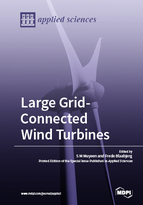Large Grid-Connected Wind Turbines
A special issue of Applied Sciences (ISSN 2076-3417). This special issue belongs to the section "Energy Science and Technology".
Deadline for manuscript submissions: closed (30 September 2018) | Viewed by 51074
Special Issue Editors
Interests: renewable energy and smart grids
Special Issues, Collections and Topics in MDPI journals
Interests: power electronics and its applications in motor drives; wind turbines; PV systems; harmonics; reliability of power electronic systems
Special Issues, Collections and Topics in MDPI journals
Special Issue Information
Dear Colleagues,
The renewable energy penetration rate has increased rapidly since the last decade. Some countries are already generating more than 50% of their required energy from renewable sources and they are moving towards 100% renewables. Among the different renewable sources, such as wind, solar, biomass/biogas, tidal, geothermal, etc., wind energy is playing a vital role in the energy market and is competing with the traditional power industry. 10 MW class wind turbines will be available commercially in the near future and growth will continue.
To maximize the energy production from wind turbines, and transfer this power to the power grid, different types of power electronic converters are being used presently as interfacing devices. With increased turbine size, grid interfacing technologies are getting more complex. Large wind turbines are, not only supplying grid power, but are also supposed to provide some ancillary services to the grid. Controller and filter design tasks are becoming more complex. System stability is becoming a headache for transmission and distribution operators, when large scale wind farms are connected with existing weak networks. The energy storage system appears as a crucial part of grid tied to large scale wind turbine generator systems. This Special Issue aims to collect important works addressing the stability, variability, and scalability of large-scale, wind-turbine, grid-interfacing techniques and challenges.
Assoc. Prof. Dr. S. M. MuyeenProf. Dr. Frede Blaabjerg
Guest Editors
Manuscript Submission Information
Manuscripts should be submitted online at www.mdpi.com by registering and logging in to this website. Once you are registered, click here to go to the submission form. Manuscripts can be submitted until the deadline. All submissions that pass pre-check are peer-reviewed. Accepted papers will be published continuously in the journal (as soon as accepted) and will be listed together on the special issue website. Research articles, review articles as well as short communications are invited. For planned papers, a title and short abstract (about 100 words) can be sent to the Editorial Office for announcement on this website.
Submitted manuscripts should not have been published previously, nor be under consideration for publication elsewhere (except conference proceedings papers). All manuscripts are thoroughly refereed through a single-blind peer-review process. A guide for authors and other relevant information for submission of manuscripts is available on the Instructions for Authors page. Applied Sciences is an international peer-reviewed open access semimonthly journal published by MDPI.
Please visit the Instructions for Authors page before submitting a manuscript. The Article Processing Charge (APC) for publication in this open access journal is 2400 CHF (Swiss Francs). Submitted papers should be well formatted and use good English. Authors may use MDPI's English editing service prior to publication or during author revisions.
Keywords
- Wind Turbine Generator System
- Offshore Wind Farm
- Energy Storage System
- Grid Interfacing Power Converters
- Power Quality
- Fault Ride Through
- Synthetic Inertia







